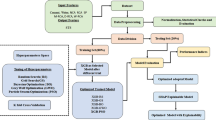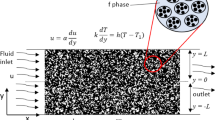Abstract
Engineering infrastructure includes a large number of concrete structures. The main binder used in concrete is Portland cement, which reacts with water when mixing. During the chemical reaction (cement hydration) heat is released causing non-uniform temperature distribution and subsequent internal stresses that may crack the concrete. Therefore, accurate prediction of concrete temperature evolution in design and control of concrete temperature in construction are crucial tasks for engineers. This paper presents the development of a finite difference (FD) model for predicting thermal behavior of concrete structures during cement hydration. A formwork or insulation layer that covers the outer of the concrete was accounted for in the model. The temperature profiles calculated by the proposed model show close agreement with those measured from a concrete bridge footing and a concrete cube. The Particle Swarm Optimization (PSO) algorithm was adopted to compute an “equivalent convection coefficient” for the convection boundary condition in the simplified model for several common insulation materials. The results show that using the simplified model along with an equivalent convection coefficient can give a significant reduction in the computation time while the accuracy is still maintained. In addition, an equation for estimating an equivalent convection coefficient for a given insulation material was developed for design and practical purposes. The proposed method can be used in the design of concrete structures and control of concrete temperature to prevent early-age thermal cracking thus ensuring the expected durability and service life. From the obtained results, varying equivalent convection values are also recommended to be used for different insulation materials.
Similar content being viewed by others
References
ACI 207.1R-05 (2005) Guide to mass concrete. American Concrete Institute, Farmington Hills, MI, USA
ASTM C1679-08 (2008) Standard practice for measuring hydration kinetics of hydraulic cementitious mixtures using isothermal calorimetry. American Society for Testing Materials, West Conshohocken, Pennsylvania
ASTM C1702-09a (2009) Standard test method for measurement of heat of hydration of hydraulic cementitious materials using isothermal conduction calorimetry. American Society for Testing Materials, West Conshohocken, Pennsylvania
Ballim Y (2004) A numerical model and associated calorimeter for predicting temperature profiles in mass concrete. Cement and Concrete Composites 26(6):695–703, DOI: https://doi.org/10.1016/S0958-9465(03)00093-3
Bombich AA, Garner S, Norman CD (1991) Evaluation of parameters affecting thermal stresses in mass concrete. Concrete Technology Information Analysis Center Vicksburg MS
Branco FA, Mendes P, Mirambell E (1992) Heat of hydration effects in concrete structures. Materials Journal 89(2):139–145
Cengel Y (2014) Heat and mass transfer: Fundamentals and applications. McGraw-Hill Higher Education
Chen HLR, Mardmomen S, Leon G (2020) On-site measurement of heat of hydration of delivered mass concrete. Construction and Building Materials 121246, DOI: https://doi.org/10.1016/j.conbuildmat.2020.121246
Do TA (2014) Influence of footing dimensions on early-age temperature development and cracking in concrete footings. Journal of Bridge Engineering 20(3):06014007, DOI: https://doi.org/10.1061/(ASCE)BE.1943-5592.0000690
Do TA, Chen H, Leon G, Nguyen T (2019) A combined finite difference and finite element model for temperature and stress predictions of cast-in-place cap beam on precast columns. Construction and Building Materials 217:172–184, DOI: https://doi.org/10.1016/j.conbuildmat.2019.05.019
Do TA, Lawrence A, Tia M, Bergin M (2013) Importance of insulation at the bottom of mass concrete placed on soil with high groundwater. Transportation Research Record: Journal of the Transportation Research Board 2342:113–120, DOI: https://doi.org/10.3141/2342-14
Do TA, Lawrence A, Tia M, Bergin M (2014a) Determination of required insulation for preventing early-age cracking in mass concrete footings. Transportation Research Record: Journal of the Transportation Research Board 2441:91–97, DOI: https://doi.org/10.3141/2441-12
Do TA, Lawrence AM, Tia M, Bergin MJ (2014b) Effects of thermal conductivity of soil on temperature development and cracking in mass concrete footings. Journal of Testing and Evaluation 43(5):1078–1090, DOI: https://doi.org/10.1520/JTE20140026
Do TA, Minh LH, Thac NQ, Duc TT, Quoc TT (2020) Evaluation of methods for analyzing early-age cracking risk in concrete walls of tunnel structures. Transport and Communications Science Journal DOI: https://doi.org/10.47869/tcsj.71.7.2
Do TA, Tia M, Nguyen TH, Hoang TT, Tran TD (2022) Assessment of temperature evolution and early-age thermal cracking risk in segmental high-strength concrete box girder diaphragms. KSCE Journal of Civil Engineering 26(1):166–182, DOI: https://doi.org/10.1007/s12205-021-2148-5
Do TA, Verdugo D, Tia M, Hoang TT (2021) Effect of volume-to-surface area ratio and heat of hydration on early-age thermal behavior of precast concrete segmental box girders. Case Studies in Thermal Engineering 28:101448, DOI: https://doi.org/10.1016/j.csite.2021.101448
Eberhart R, Kennedy J (1995) A new optimizer using particle swarm theory. MHS’95. Proceedings of the Sixth International Symposium on Micro Machine and Human Science, Ieee
Hansen PF, Pedersen E (1984) Curing of concrete structures, BKI
Hansen PF, Pedersen EJ (1977) Maturity computer for controlled curing and hardening of concrete
KCI (2003) Standard specification for concrete. Korea Concrete Institute, Seoul, Korea
Khatir S, Dekemele K, Loccufier M, Khatir T, Wahab MA (2018) Crack identification method in beam-like structures using changes in experimentally measured frequencies and Particle Swarm Optimization. Comptes Rendus Mécanique 346(2):110–120, DOI: https://doi.org/10.1016/j.crme.2017.11.008
Kim SG (2010) Effect of heat generation from cement hydration on mass concrete placement. Master of Science Iowa State University
Lawrence AM, Tia M, Ferraro CC, Bergin M (2011) Effect of early age strength on cracking in mass concrete containing different supplementary cementitious materials: Experimental and finite-element investigation. Journal of Materials in Civil Engineering 24(4):362–372, DOI: https://doi.org/10.1061/(ASCE)MT.1943-5533.0000389
Lee Y, Choi MS, Yi ST, Kim JK (2009) Experimental study on the convective heat transfer coefficient of early-age concrete. Cement and Concrete Composites 31(1):60–71, DOI: https://doi.org/10.1016/j.cemconcomp.2008.09.009
Lin Y, Chen HL (2015) Thermal analysis and adiabatic calorimetry for early-age concrete members. Journal of Thermal Analysis and Calorimetry 122(2):937–945, DOI: https://doi.org/10.1007/s10973-015-4843-2
Lin Y, Chen HL (2016) Thermal analysis and adiabatic calorimetry for early-age concrete members. Journal of Thermal Analysis and Calorimetry 124(1):227–239, DOI: https://doi.org/10.1007/s10973-015-5131-x
Mostafa N, Brown P (2005) Heat of hydration of high reactive pozzolans in blended cements: Isothermal conduction calorimetry. Thermochimica Acta 435(2):162–167
Nguyen CT, Do TA, Hoang TT, Tran TD (2021) Evaluation of early-age cracking risk In mass concrete footings under different placement conditions. Revista Ingeniería de Construcción 36(1):05–13, DOI: https://doi.org/10.4067/S0718-50732021000100005
Ozawa S (1962) Study on the early age cracking of massive concrete and its prevention measure. Water Power for Electric Generation 57:254–261
Poole JL (2007) Modeling temperature sensitivity and heat evolution of concrete. The University of Texas at Austin
Rastrup E (1954) Heat of hydration in concrete. Magazine of Concrete Research 6(17):79–92
Riding KA (2007) Early age concrete thermal stress measurement and modeling
Riding KA, Poole JL, Folliard KJ, Juenger MC, Schindler AK (2012) Modeling hydration of cementitious systems. ACI Materials Journal 109(2):225–234
Schindler AK, Folliard KJ (2005) Heat of hydration models for cementitious materials. ACI Materials Journal 102(1):24
Shabbir F, Omenzetter P (2015) Particle swarm optimization with sequential niche technique for dynamic finite element model updating. Computer-Aided Civil and Infrastructure Engineering 30(5):359–375, DOI: https://doi.org/10.1111/mice.12100
Shao L, Bai Y, Qiu Y, Du Z (2012) Particle swarm optimization algorithm based on semantic relations and its engineering applications. Systems Engineering Procedia 5:222–227, DOI: https://doi.org/10.1016/j.sepro.2012.04.035
Tao C, Watts B, Ferraro CC, Masters FJ (2019) A multivariate computational framework to characterize and rate virtual Portland cements. Computer-Aided Civil and Infrastructure Engineering 34(3):266–278, DOI: https://doi.org/10.1111/mice.12413
Tran-Ngoc H, Khatir S, De Roeck G, Bui-Tien T, Nguyen-Ngoc L, Abdel Wahab M (2018) Model Updating for Nam O Bridge Using Particle Swarm Optimization Algorithm and Genetic Algorithm. Sensors 18, DOI: https://doi.org/10.3390/s18124131
Waller V, d’Aloïa L, Cussigh F, Lecrux S (2004) Using the maturity method in concrete cracking control at early ages. Cement and Concrete Composites 26(5):589–599, DOI: https://doi.org/10.1016/S0958-9465(03)00080-5
Wei Z, Liu J, Lu Z (2018) Structural damage detection using improved particle swarm optimization. Inverse Problems in Science and Engineering 26(6):792–810, DOI: https://doi.org/10.1080/17415977.2017.1347168
Wu Q, Cole C, McSweeney T (2016) Applications of particle swarm optimization in the railway domain. International Journal of Rail Transportation 4(3):167–190, DOI: https://doi.org/10.1080/23248378.2016.1179599
Yamagawa, Kasagi, Gobayashi (1982) Investigation of an experimental method for thermal convective coefficient of massive concrete. Proceedings of Japan Society of Civil Engineers
Yikici TA, Chen HL (2015) Numerical prediction model for temperature development in mass concrete structures. Transportation Research Record: Journal of the Transportation Research Board 2508:102–110, DOI: https://doi.org/10.3141/2508-13
Acknowledgments
This research is funded by the University of Transport and Communications (UTC) under grant number T2021-CT-006TÐ.
Author information
Authors and Affiliations
Corresponding author
Rights and permissions
About this article
Cite this article
Nguyen-Ngoc, L., Do, T.A., Hoang, V.H. et al. Equivalent Convective Heat Transfer Coefficient for Boundary Conditions in Temperature Prediction of Early-Age Concrete Elements Using FD and PSO. KSCE J Civ Eng 27, 2546–2558 (2023). https://doi.org/10.1007/s12205-023-1116-7
Received:
Revised:
Accepted:
Published:
Issue Date:
DOI: https://doi.org/10.1007/s12205-023-1116-7




